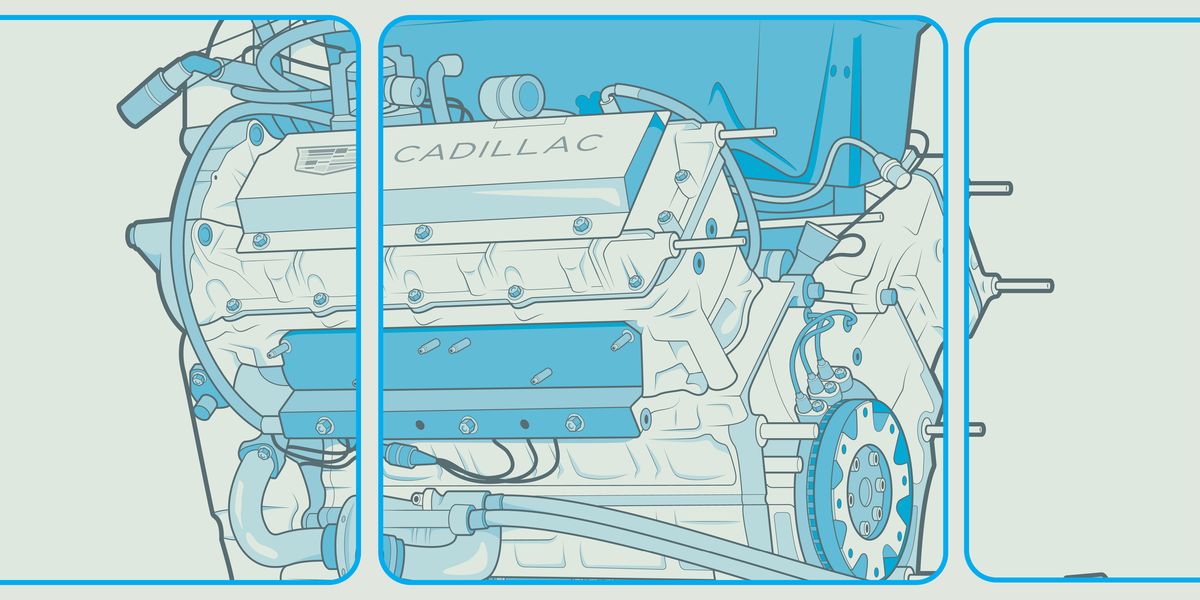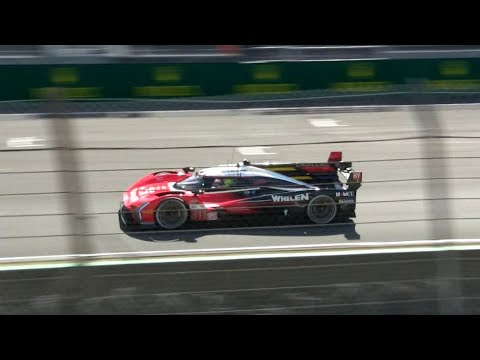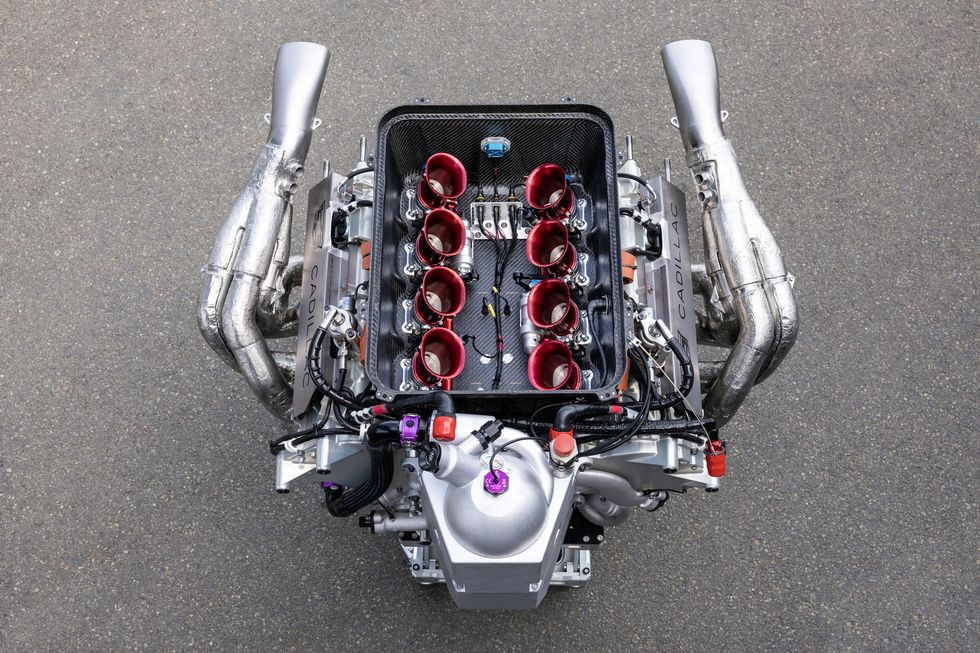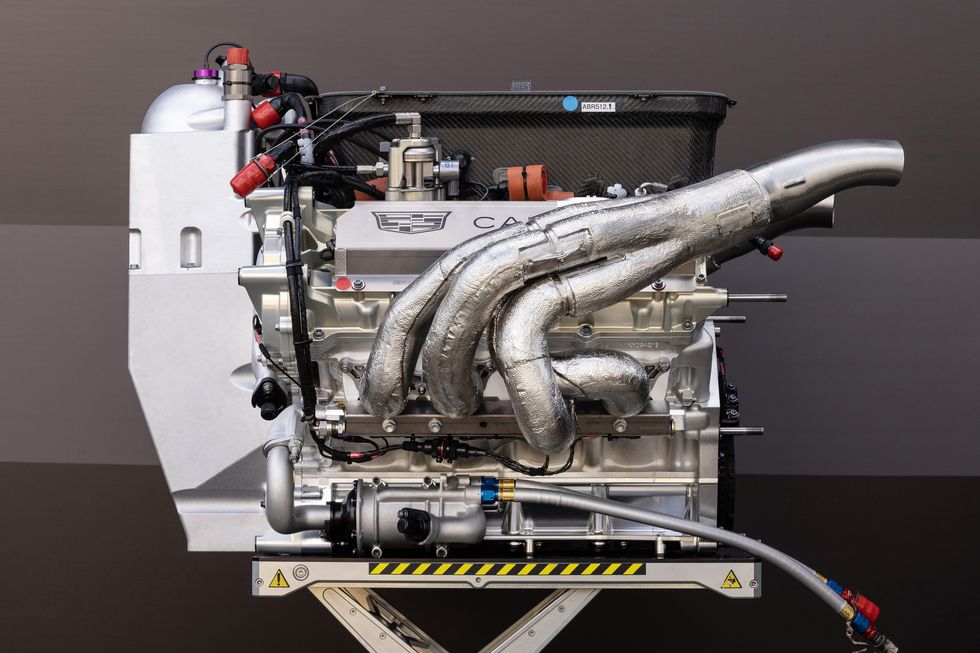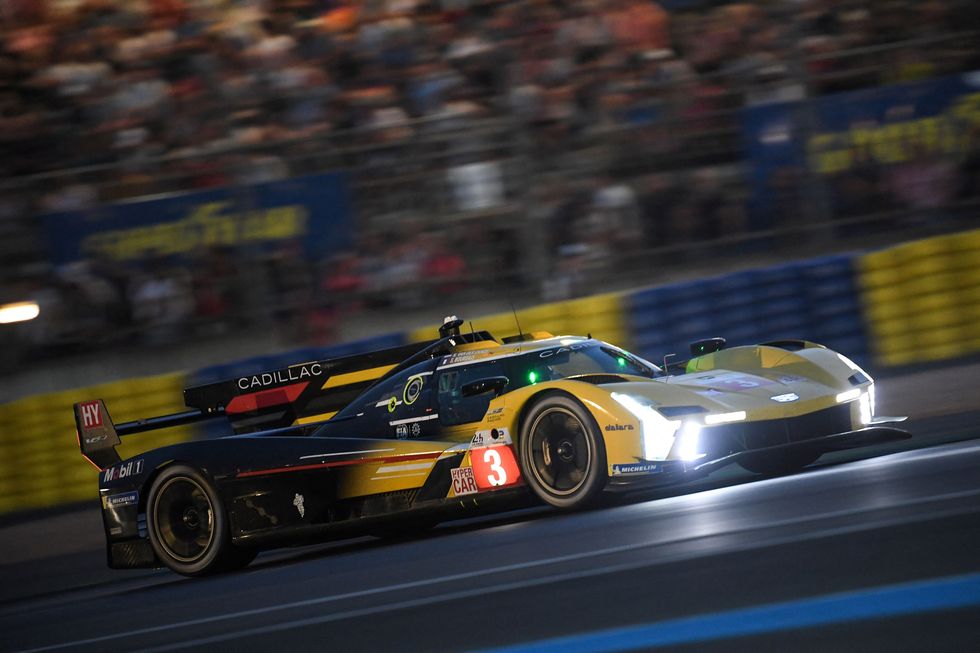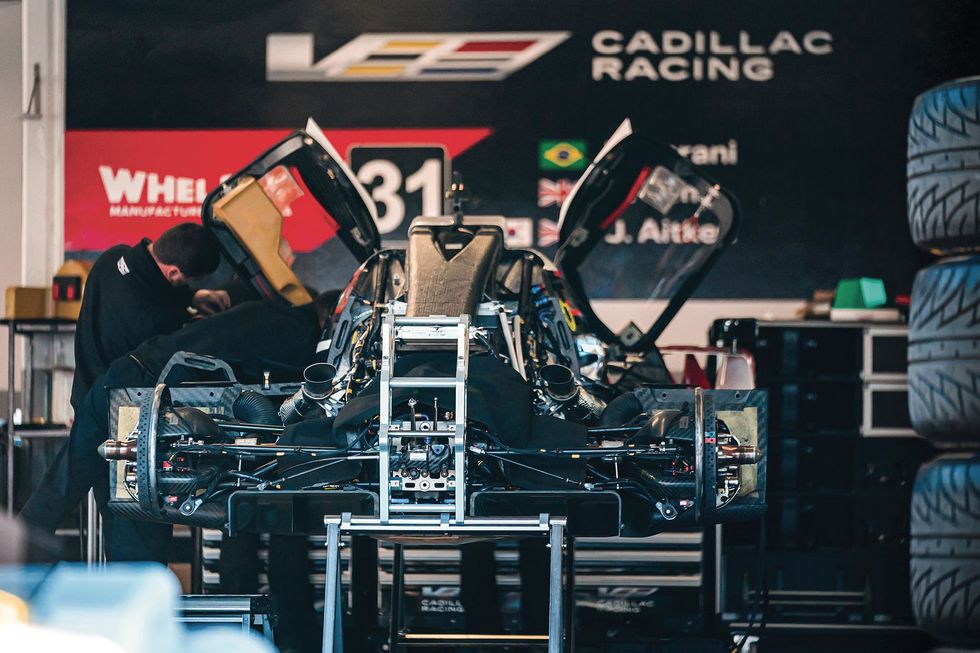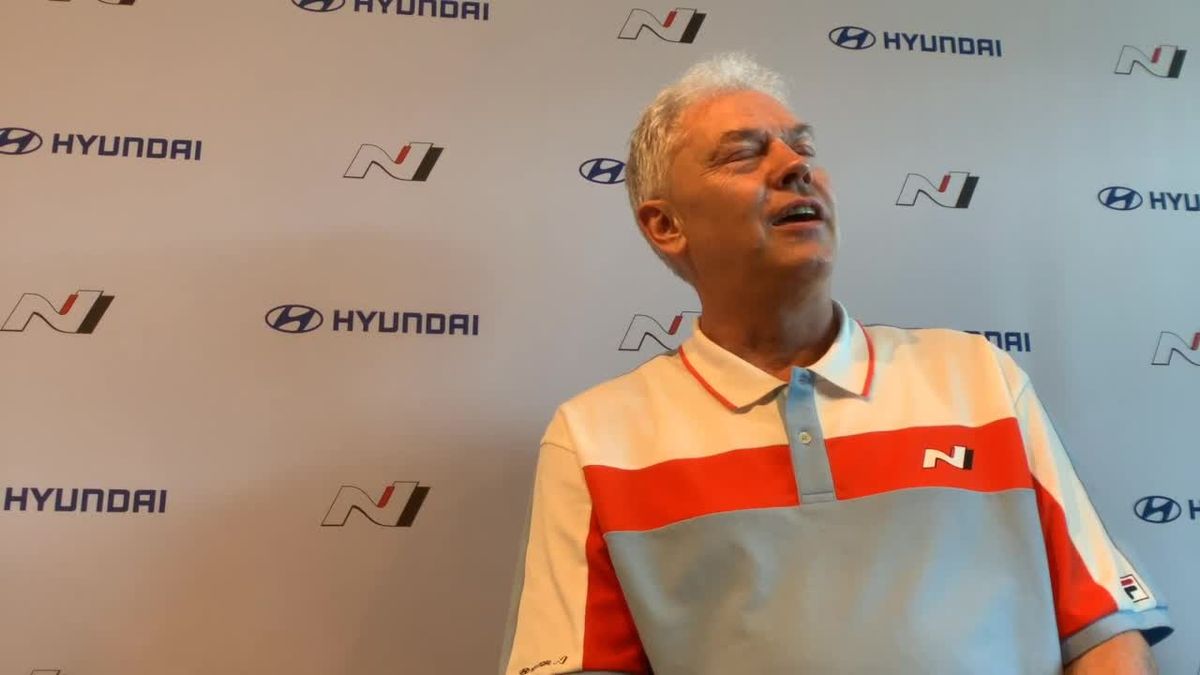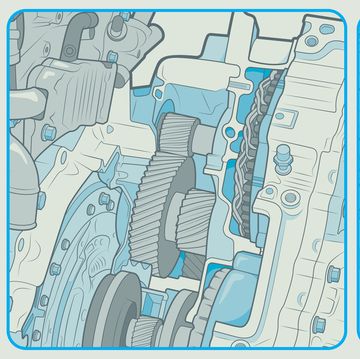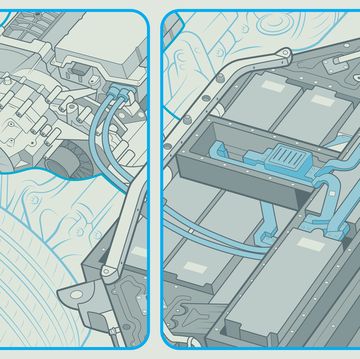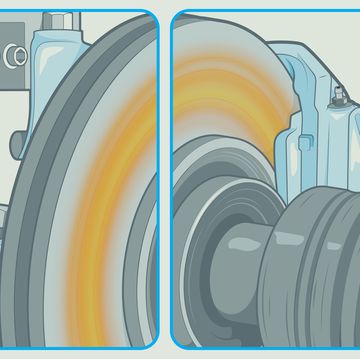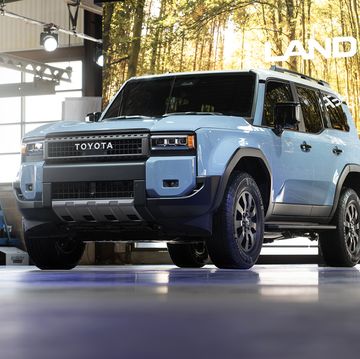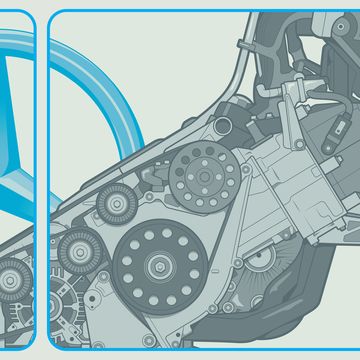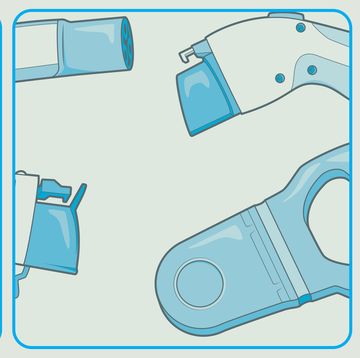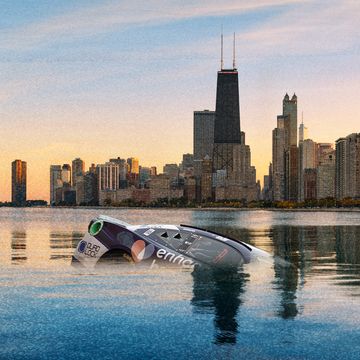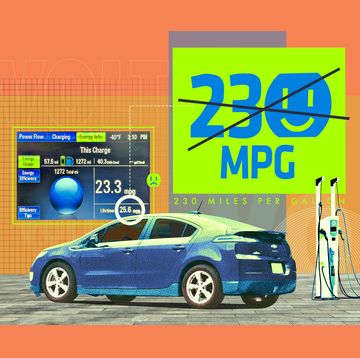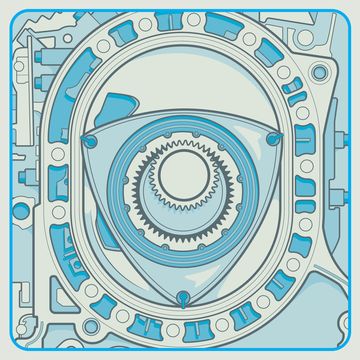Only the Camaro was louder at Le Mans. The Cadillac V-Series.R sang a familiar American tune at La Sarthe, its V-8 screaming like so many of the greats this country has produced before it. No other Hypercar came close to offering similar aural delight.
Cadillac developed a new engine for the V-Series.R, a car built to IMSA and the ACO’s LMDh regulations. The LMDh ruleset takes an interesting approach to the internal-combustion engine (ICE). There’s no requirement for the ICE to be based on a production-car engine, just that it’s a four-stroke petrol-powered engine revving no higher than 10,000 RPM. (There’s no requirement for it to use pistons either, so if an automaker wanted to develop a rotary engine, it could.) The wheelbase of an LMDh car is fixed, and that therefore limits engine length to 25.2 inches, and there’s also a 396.8-pound weight limit. IMSA and the ACO have restrictions on some exotic materials as well, and all engines must be paired with the LMDh spec hybrid system, which consists of a Bosch electric motor integrated into an Xtrac transaxle. The combined power of the ICE and electric motor must not exceed between 644 and 697 horsepower depending on Balance of Performance (BoP), and while there’s a maximum output for the e-motor, there’s no minimum.
The idea for Cadillac, and everyone else, is to make enough power with the ICE to hit the maximum rear-axle output on its own. “As long as you can meet that power reliably,” says Adam Trojanek, lead propulsion engineer for the Cadillac LMDh program, “you start to get away from the focus of making as much power as possible and then start looking at ‘What's the most efficient way to make that power?’ Not only in terms of the mechanics of a combustion engine and making that efficient, but also in terms of a race car. What’s the best way to make that power reliably...with the fewest amount of objects to possibly break on a car?”
The engineers decided that a bespoke 5.5-liter naturally aspirated V-8, codenamed LMC55R, was the right call here. It’s much larger than anything used by the opposition, whose engines range from 2.4 to 4.6 liters, and it’s the only LMDh car without turbochargers. The only other naturally aspirated car racing in the Hypercar class at Le Mans, which includes cars built to the LMH ruleset, is the Vanwall Vandervell, which uses an off-the-shelf V-8 from longtime racing supplier Gibson.
“When you start looking at turbo applications, everyone says ‘Oh, you know, turbos are more efficient and stuff like that,’” Trojanek says. “But combustion efficiency on N/A motors has gotten to a point now where it’s worth it to go with a naturally aspirated motor to save the weight of a turbo and intercooler.”
Trojanek says that the 396.8-pound weight target for the engine—which also includes cooling and exhaust components—is an “aggressive” target on its own, so even without turbos, it was still somewhat of a challenge to get as close to that figure as possible. But, there’s also a minimum weight target for the entire car and ditching turbos gives Cadillac a little more freedom when it comes to ballast and other necessary components. In other words, the weight saved from opting for natural aspiration isn’t put back directly into the engine itself. Going non-turbo can also, in theory, aid reliability as there’s just fewer parts to break.
An N/A V-8 also just felt right for Cadillac and GM at large. “Another part of racing is that you know OEMs work really hard to make sure that the racing cars match what we have in our road cars as well and try to take lessons learned,” Trojanek says. “So, one big play and one good learning advantage of doing it naturally aspirated V-8 is that extends to other portfolio products that that General Motors offers.”
While GM has introduced its first modern flat-plane crank V-8 in the form of the LT6 used in the Chevrolet Corvette Z06, the company has a much longer association with cross-plane crankshafts. Typically, a flat-plane V-8 revs higher and thus makes more peak horsepower than its cross-plane counterpart, as the crankshaft itself is lighter. This comes at the expense of vibrations as a flat-plane V-8 is inherently unbalanced, which is why you only see them in high-performance road and racing applications. Other than the Camaro at Le Mans, the Cadillacs had the only other cross-plane V-8s in the field. Trojanek says that the Cadillac team was able to create a cross-plane crankshaft that weighed slightly less than some of the flat-plane options it evaluated, but the engine still revs to 8800 rpm. Plus, the cross-plane crank gave the V-Series.R its unique aural signature, making it easily distinguishable on any grid you’d find it on.
The vibrations of a flat-plane V-8 get worse as engine size increases, and with GM’s selection of 5.5 liters to provide the requisite power and torque, taming the unbalanced nature of a flat-plane design would be extremely difficult. In the V-Series.R, as with all modern prototype race cars, the engine is bolted directly to the central monocoque, making it a structural member of the car’s chassis. Those vibrations could transfer to other parts of the car, like the suspension, and wreak havoc. It’s not an issue the Corvette Z06 road car and C8.R race car face as their V-8s aren’t structural members.
This engine does break with the tradition established by GM’s most famous cross-plane V-8, the Small Block, as it has dual overhead camshafts and four valves per cylinder. Trojanek says the team did consider a pushrod V-8, which would have continued the lineage from the brand’s DPi-V.R prototype, which had a small-block based V-8. “In the grand scheme of things, a pushrod motor can save a bit more weight,” he said, “but we felt pretty confident that this dual overhead cam motor would make the power a bit more easily due to its better flow characteristics.” While making a pushrod, four-valve engine is possible, it’s complicated, which is why no one does it. A four-valve cylinder head has more total valve area, allowing better airflow in and out. The added weight was worth the compromise.
And of course, there’s the hybrid components. While the hardware for the LMDh hybrid system is shared across all competitors, the software is defined by the entrant. The first wave of hybrid roadgoing hypercars—Porsche 918, McLaren P1, and Ferrari LaFerrari—all used a strategy called torque fill, where the hybrid system was used to compensate the torque gaps of a peaky ICE. With the V-Series.R, Cadillac doesn’t do this. “In terms of deployment, you know it, we really just use it as an opportunity to not make up for shortcomings, but to kind of make like a good energy balance,” Trojanek says. “So, trying to optimize where on track should we use more hybrid and less ICE, or or vice versa.” It’s defined by both vehicle dynamics and race strategy. “Ultimately, it's not like the hybrid systems is additive to the engine... You have to make an axle power number and that’s it.”
Its American tune may be familiar, but the LMC55R engine is its own beast. Trojanek says that other than a few fasteners, it shares nothing with other General Motors engines. So far, it’s performing well in the V-Series.R, with the car notching up victories at Sebring and Laguna Seca and finishing on the podium at Le Mans. And on the reliability side of things, only one V-Series.R has failed to finish a race thus far.
So, it’s not just the sound that makes an impression.
A car enthusiast since childhood, Chris Perkins is Road & Track's engineering nerd and Porsche apologist. He joined the staff in 2016 and no one has figured out a way to fire him since. He street-parks a Porsche Boxster in Brooklyn, New York, much to the horror of everyone who sees the car, not least the author himself. He also insists he's not a convertible person, despite owning three.
